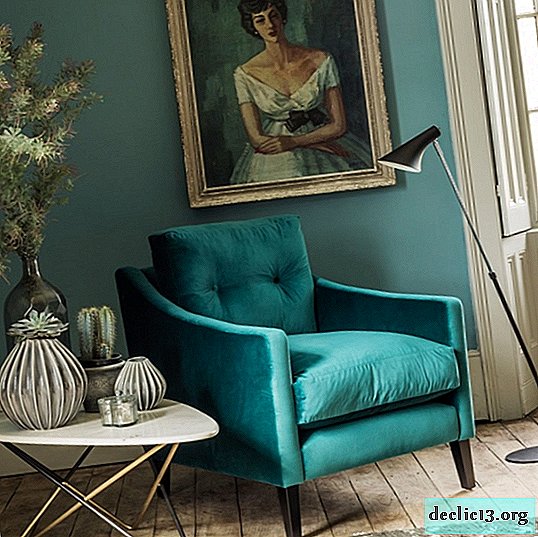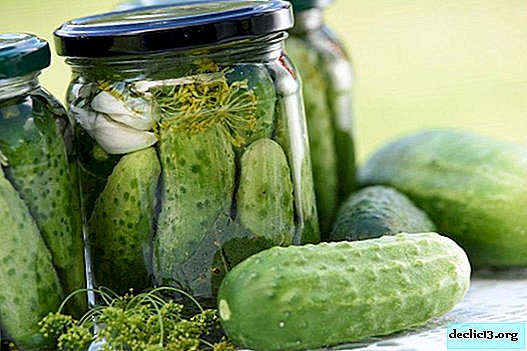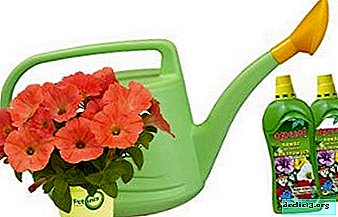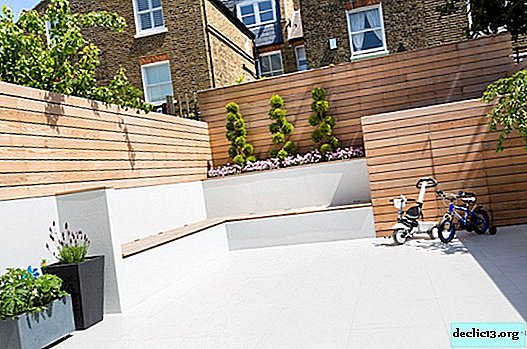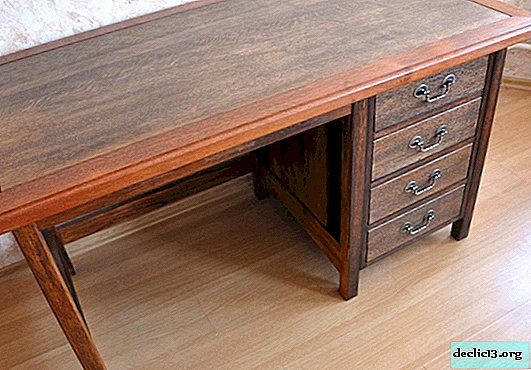Unpretentious and luxurious streptocarpus flower, care and its decorative application
 When it comes to choosing a plant for growing indoors, it is important that it is not afraid of temperature and moisture changes. These include an unusual plant that blooms incredibly luxuriously - streptocarpus.
When it comes to choosing a plant for growing indoors, it is important that it is not afraid of temperature and moisture changes. These include an unusual plant that blooms incredibly luxuriously - streptocarpus.
An unpretentious flower is able to please an exceptionally long and lush flowering, subject to certain subtleties. In this article you will learn about the beneficial properties of this flower and the features of caring for it. Also watch a useful video on this topic.
Description, main types, useful properties
Streptocarpus is a rosette plant. It has a shortened stalk that grows in breadth. The leaves of the streptocarpus are quite long (reach a length of about 30 cm), they have a wrinkled structure and are very pubescent. Peduncles consist of 2-3 fairly dense flowers. One plant can grow up to 100 flowers at a time. They look like small bells with elongated lower petals.
Presented in a wide range of shades:
- Violet;
- blue;
- lavender;
- white;
- red and so forth
 The name of the plant is translated from Latin as "twisted box." It received it because of the unusual appearance of the seeds, which look like a twisted box and appear after the end of the flowering period of streptocarpus. Initially, the Cape Province of South Africa is considered the birthplace of the flower, so it is sometimes called the Cape Primrose.
The name of the plant is translated from Latin as "twisted box." It received it because of the unusual appearance of the seeds, which look like a twisted box and appear after the end of the flowering period of streptocarpus. Initially, the Cape Province of South Africa is considered the birthplace of the flower, so it is sometimes called the Cape Primrose.
Streptocarpus hails from the rainforests of South Africa and Asia, from where it was exported to Europe in the middle of the 19th century. The plant blooms from late spring to summer. Despite its luxurious appearance, streptocarpus does not smell at all. He attracts insects solely due to his unusual bright color.
IMPORTANT: Streptocarpus lives no more than three years. After this, it is undesirable to continue growing this plant, since it takes on an unsightly "haggard" look.Today, there are more than 130 varieties of streptocarpus. Each of them belongs to one of three main types:
- Rosette. This may include all hybrid varieties of streptocarpus. Flowers usually grow very large, assembled into one large outlet.
- Single leaf. The plant is quite powerful. Its main sheet can reach a height of 1 m, and more than 0.5 m in width. Some varieties belonging to this type may have an additional underdeveloped pair of leaves.
- Multi-sheeted. This is a creeping plant that blooms magnificently with a large number of small flowers.
Florists give preference to the first type of plant. Most rosette varieties have wide, well-developed leaves with a wrinkled surface, in the sinuses of which no more than 2 peduncles grow. Streptocarpus cannot be called a poisonous plant, but science and medicine are still unknown about its beneficial properties.
Photo
The photo shows various plant varieties with names, including DS-February.
DS-February

"Marine patterns"

"Spring Dreams"

"Envy of the gods"

“Snow of Kilimonjaro”

Reproduction of streptocarpus
Seeds
For successful germination of streptocarpus seeds, certain rules must be observed:
- Planting seeds should be carried out in a moist substrate (it must first be watered), consisting of perlite, vermiculite and chopped peat.
- To simplify the process of planting seeds, mix them first with fine sand.
- Immediately after sowing the seeds, the soil in the container with seedlings should be moistened with a spray bottle and covered with transparent glass or polyethylene.
- Leave the pot with sown seeds in a warm, bright place with an air temperature of at least 21-25 degrees.
- An improvised greenhouse should be ventilated with the accumulation of a large amount of condensate.TIP: When young seedlings have two full leaflets - dive them into separate pots with prepared soil consisting of peat, moss, leafy earth and vermiculite with perlite (component ratio 3: 2: 2: 1: 1).
Watch a video about growing streptocarpus from seeds:
Streptocarpus is often propagated by cuttings, and the leaves of the plant or even part of it are often used as cuttings:
- Initially, the sheet slice should be treated with crushed charcoal.
- Then immerse in a container with rain or melt water. The slice should be immersed in water at 0.5-1 cm.
- From above, the container with water and seedlings should be covered with transparent glass / film to create a greenhouse effect. Periodically open the container to eliminate condensation.
Watch a video on the propagation of streptocarpus by cuttings from leaf fragments:
For growing streptocarpus, experienced gardeners prefer to use a method that does not require rooting - the “toaster method”:
- The leaf is cut along the central vein, which succeeds.
- The result is two halves of the sheet.
- They should be treated with chopped charcoal, and then planted, folded in a toaster, into the ground to a depth of about 0.5 cm.
You can learn more about growing and breeding streptocarpus here, and here we talked about how to propagate it with a leaf and from seeds.
Houseplant Care
The process of caring for streptocarpus is quite simple and involves the following procedures:
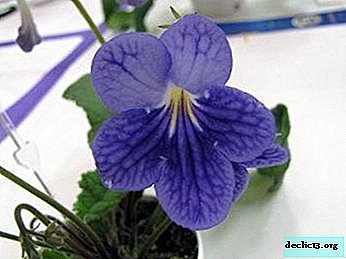 Humidification. Streptocarpus needs a certain level of humidity. At the same time, water should not fall on the leaves of the plant, so spraying flowers is considered the best option to achieve the desired result.
Humidification. Streptocarpus needs a certain level of humidity. At the same time, water should not fall on the leaves of the plant, so spraying flowers is considered the best option to achieve the desired result.- Watering. They must be regular, but not excessive, so as not to rot the root system of the plant. In the summer, it is necessary to moisten the soil 2-3 per week, but the water should not be in the pot. In winter, it is enough to saturate the soil with water once a week, or even less often. Water should be settled or purified. Inspect the plant periodically to see how much moisture it needs: when the soil is too dry, the leaves lose their elasticity.
- Top dressing. Fertilize the plant carefully and regularly with a frequency of at least 2 times a month. Top dressing for flowering plants is used. This will help accelerate the growth of streptocarpus and its flowering, as well as strengthen the immune system.
- Pruning. The plant must be periodically cleaned of dust and cut off any damaged, diseased or old leaves. Use a light whisk to remove dust.
You can read more about caring for streptocarpus here.
Transplant Rules
The procedure is best carried out before the beginning of the active growth of streptocorpus - in early spring. Since the root system of the plant is superficial, although powerful enough, it is better to choose a wide rather than deep capacity. When transplanting the plant, each subsequent pot should be 2-3 cm wider than the previous one.
The soil should be selected nutritious, but at the same time light and moderately loose. So that the water does not stagnate in the pot after irrigation, it is necessary to make a drainage layer in the pot at least 2 cm deep. A soil layer is poured on top of the drainage, then the plant is transferred to a new pot with an old earthen lump and sprinkled on top of the ground.
Watch the video on the correct transplant of streptocarpus:
Winter period
The streptocarpus does not have a pronounced dormant period: under certain conditions, the plant can bloom year-round. This will require constant temperature, high-quality lighting, etc. But only adults who have lived plants for more than one year are suitable for such a life, but young specimens in winter should be left alone: watering is minimized, lighting and air temperature are reduced, and feeding is completely stopped.
Decorative application
Some time ago, a flower was not very popular among gardeners and florists, but in recent years a large number of new varieties of this wonderful plant have been bred, differing in their incredible appearance and capable of decorating any house or small greenhouse. The color scheme of the new species is so diverse, and the care is so simple that the attitude towards the flower has changed dramatically.
Florists prefer to grow it, and Florists use streptocarpus in composing luxurious compositions due to several features:
- The plant is unpretentious and does not cause much trouble even a beginner grower.
- With proper care, streptocarpus blooms for a very long time and is incredibly magnificent.
- Easily propagated by any part.
- With proper lighting, you can achieve year-round flowering plants.
- Even after the end of the flowering period, the plant impresses with its amazing appearance.
Diseases and their treatment
To prevent the development of diseases, it is necessary, first of all, to monitor the appearance of the plant and provide it with quality care. This will maintain its immunity and root system in perfect order. At the first signs of “unhealthy”, the diseased plant should be isolated and all damaged parts removed immediately.
Among the most frequently affecting plant diseases and pests, the following can be distinguished:
 Thrips. The leaves of the plant begin to dry actively and stop this process is extremely difficult. Method of control: the use of an insecticide. But, first of all, it is necessary to change the level of humidity and temperature in the room. The disease manifests itself when the room where the streptocarpus grows is too hot and the humidity level is too low.
Thrips. The leaves of the plant begin to dry actively and stop this process is extremely difficult. Method of control: the use of an insecticide. But, first of all, it is necessary to change the level of humidity and temperature in the room. The disease manifests itself when the room where the streptocarpus grows is too hot and the humidity level is too low.- Late blight or virus. When the disease manifests itself, the leaves begin to become covered with dark mosaic spots. It is almost impossible to cure a large plant, so you should immediately destroy it.
- Spider mite. The presence of cobwebs on the leaves and the drying of peduncles is a clear sign of the presence of a spider mite. You can get rid of it by applying the same drugs as for fighting thrips.
More information about pests and diseases of streptocarpus can be found in this article.
To prevent the development of diseases, carry out periodic prophylaxis: treat plants, for example, with a fitoverm. These are the main features and nuances that you should know about streptocarpus and be sure to observe them in order to successfully grow this beautiful plant at home and enjoy its extraordinary flowering.

 Humidification. Streptocarpus needs a certain level of humidity. At the same time, water should not fall on the leaves of the plant, so spraying flowers is considered the best option to achieve the desired result.
Humidification. Streptocarpus needs a certain level of humidity. At the same time, water should not fall on the leaves of the plant, so spraying flowers is considered the best option to achieve the desired result. Thrips. The leaves of the plant begin to dry actively and stop this process is extremely difficult. Method of control: the use of an insecticide. But, first of all, it is necessary to change the level of humidity and temperature in the room. The disease manifests itself when the room where the streptocarpus grows is too hot and the humidity level is too low.
Thrips. The leaves of the plant begin to dry actively and stop this process is extremely difficult. Method of control: the use of an insecticide. But, first of all, it is necessary to change the level of humidity and temperature in the room. The disease manifests itself when the room where the streptocarpus grows is too hot and the humidity level is too low.
